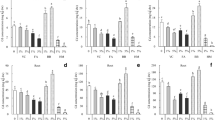Abstract
A revolving furnace slag (RFS), which is a by-product of the steel industry, and a spent disposable portable body warmer (PBW), which harnessed the heat of iron oxidation reaction, were used as iron materials. Portions of 4 kg of Coarse and Medium Textured Gley soil were placed into plastic pots (3 L). RFS was added to the pots at the rate of 0 (control), 10, 20, 40, 100 ton ha−1, while PBW was added at 10 ton ha−1 only. Methane flux from the potted soil with rice plants and Eh were measured during cropping seasons in 1999 and 2000. In the 1999 experiment, the RFS treatments showed lower Eh values compared with the control, especially at the early period of cultivation, although the RFS was applied to maintain the soil oxidative. The rapid decrease in Eh under high application of RFS may be due to the high pH of the RFS (pH (RFS:H2O = 1:2.5) was 12.2). However, total methane emission during the cultivation period significantly decreased, about 10%, when 10–40 ton ha−1 of RFS and 10 ton ha−1 of PBW were applied. The grain yield was significantly increased, about 30%, when 40 or 100 ton ha−1 of RFS was applied. This was also partly due to the release of inorganic nutrients from RFS and also from soil. The latter, due to effect of the alkaline RFS on soil. In the 2000 experiment, the pots with soils from 1999 were used without further application of iron materials. The influence of high application of RFS on soil Eh disappeared, compared with 1999. Total methane emission significantly decreased, about 35%, at 20 ton ha−1 of RFS. However, the increase of grain yield caused by RFS in 1999 was diminished, compared with 1999. Production activity of both methane and carbon dioxide at the RFS treatments were decreased, while methane oxidizing activity was increased. The decrease in total methane emission may be attributed to not only inhibition of methane production but also enhanced methane oxidation. In conclusion, methane emission from paddy soil could be suppressed, over two cropping seasons by single application of RFS without loosing grain yield.
Similar content being viewed by others
References
Asami T & Takai Y (1970) Behavior of free-iron oxide in paddy soil (Part 4) Reduction of free-iron oxide and metabolisms of various gases in paddy soil. Jpn J Soil Sci Plant Nutr 41: 48–55 (in Japanese)
Furukawa Y, Tsuji T & Inubushi K (2001) Suppression of methane emission from paddy soil by applying with iron materials. Jpn J Soil Sci Plant Nutr 72: 257–264 (in Japanese)
Inubushi K, Hori K, Matsumoto S & Wada H (1997) Anaerobic decomposition of organic carbon in paddy soil in relation to methane emission to the atmosphere. Wat Sci Tech 36: 523–530
Inubushi K, Wada H & Takai Y (1984) Easily decomposable organic matter in paddy soil, IV. Relationship between reduction process and organic matter decomposition. Soil Sci Plant Nutr 30: 189–198
IPCC (Intergovernmental Panel on Climate Change) (1996) Climate Change 1995, Impacts, Adaptation and Mitigation of Climate Change, p 572. Cambridge University Press, Cambridge, UK
Kai H (1978) Transformation and availability of nitrogen in paddy soil. In: Kawaguchi K (ed) Paddy Soil Science, pp 231–237. Kodan-sha, Tokyo
Kato N & Owa N (1996) The factors affecting Si concentration in the soil solution: Effects of soil solution pH, Ca concentration, CO2 gas and slag application. Jpn J Soil Sci Plant Nutr 67: 655–661 (in Japanese)
Kumada K & Asami T (1958) A new method for determining ferrous iron in paddy soils. Soil Plant Food 3: 187–193
Nozoe T, Nishibata Y, Sekiguchi T & Inoue T (1999) Effects of the addition of Fe-containing slag fertilizers on the changes in Eh in paddy soil. Soil Sci Plant Nutr 45: 729–735
Takai Y (1970) The mechanism of methane fermentation in flooded paddy soil. Soil Sci Plant Nutr 16: 238–244
The Iron Slag Society (1997) Characteristic and Utility of Iron Slag. pp 3–4. Tokyo, Japan (in Japanese)
Watanabe I, Takada G, Hashimoto T & Inubushi K (1995) Evaluation of alternative substrates for determining methane-oxidizing activities and methanotrophic populations in soils. Biol Fertil Soils 20: 101–106
Yagi K & Minami K (1990) Effect of organic matter application on methane emission from some Japanese paddy fields. Soil Sci Plant Nutr 36: 599–610
Yanagisawa M (1978) Degraded Paddy Soil. In: Kawaguchi K (ed) Paddy Soil Science, pp 425–431. Kodan-sha, Tokyo
Yoshiba M, Morimura T, Aso S & Takenaga H (1996) Methane production and control in submerged soil applied with Mn4+, Fe2+ and SO4 2− rich materials. Jpn J Soil Sci Plant Nutr 67: 362–370 (in Japanese)
Author information
Authors and Affiliations
Rights and permissions
About this article
Cite this article
Furukawa, Y., Inubushi, K. Feasible suppression technique of methane emission from paddy soil by iron amendment. Nutrient Cycling in Agroecosystems 64, 193–201 (2002). https://doi.org/10.1023/A:1021150831735
Issue Date:
DOI: https://doi.org/10.1023/A:1021150831735




